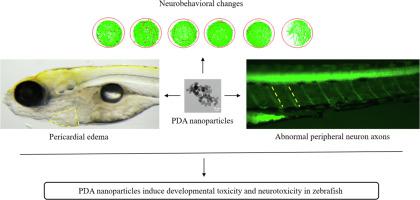NanoImpact ( IF 4.7 ) Pub Date : 2021-08-30 , DOI: 10.1016/j.impact.2021.100353 Mengqi Sun 1 , Yuanyuan Cao 1 , Qinglin Sun 1 , Xiaoke Ren 1 , Junjie Hu 1 , Zhiwei Sun 1 , Junchao Duan 1

|
Currently, the potential applications of polydopamine (PDA) nanoparticles in the biomedical field are being extensively studied, such as cell internalization, biocompatible surface modification, biological imaging, nano-drug delivery, cancer diagnosis, and treatment. However, the subsequent toxicological response to PDA nanoparticles, especially on nervous system damage was still largely unknown. In this regard, the evaluation of the neurotoxicity of PDA nanoparticles was performed in the developing zebrafish larvae. Results of the transmission electron microscope (TEM), diameter analysis, 1H NMR, and thermogravimetric analysis (TGA) indicated that PDA nanoparticles had high stability without any depolymerization; the maximum non-lethal dose (MNLD) and LD10 of PDA nanoparticles for zebrafish were determined to be 0.5 mg/mL and 4 mg/mL. Pericardial edema and uninflated swim bladders were observed in zebrafish larvae after exposure to PDA nanoparticles. At a concentration higher than MNLD, the fluorescence images manifested that the PDA nanoparticles could inhibit the axonal growth of peripheral motor neurons in zebrafish, which might affect the movement distances and speed, disturb the movement trace, finally resulting in impaired motor function. However, in further investigating the mechanism of PDA nanoparticles-induced neurotoxicity in zebrafish larvae, we did not find apoptosis of central neurocytes. Our data suggested that PDA nanoparticles might trigger neurotoxicity in zebrafish, which could provide an essential clue for the safety assessment of PDA nanoparticles.
中文翻译:

暴露于聚多巴胺纳米颗粒会在发育中的斑马鱼中诱导神经毒性
目前,聚多巴胺(PDA)纳米粒子在生物医学领域的潜在应用正在被广泛研究,如细胞内化、生物相容性表面修饰、生物成像、纳米药物递送、癌症诊断和治疗等。然而,随后对 PDA 纳米粒子的毒理学反应,特别是对神经系统损伤的毒理学反应仍然很大程度上未知。在这方面,对发育中的斑马鱼幼虫进行了 PDA 纳米颗粒的神经毒性评估。透射电子显微镜(TEM)、直径分析、1 H NMR和热重分析(TGA)的结果表明,PDA纳米粒子具有很高的稳定性,没有任何解聚;最大非致死剂量 (MNLD) 和 LD 10斑马鱼的 PDA 纳米颗粒的含量确定为 0.5 mg/mL 和 4 mg/mL。在暴露于 PDA 纳米粒子后,在斑马鱼幼虫中观察到心包水肿和未膨胀的鱼鳔。在高于MNLD的浓度下,荧光图像显示PDA纳米粒子可以抑制斑马鱼周围运动神经元的轴突生长,从而影响运动距离和速度,扰乱运动轨迹,最终导致运动功能受损。然而,在进一步研究 PDA 纳米粒子诱导斑马鱼幼虫神经毒性的机制时,我们没有发现中枢神经细胞的凋亡。我们的数据表明,PDA 纳米粒子可能会引发斑马鱼的神经毒性,这可以为 PDA 纳米粒子的安全性评估提供重要线索。











































 京公网安备 11010802027423号
京公网安备 11010802027423号